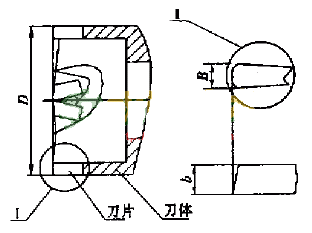The processing of the gearbox housing hole system is a typical process problem often encountered in the production of automobiles and tractors. Due to the limitation of the blank production process, the margin of the prefabricated holes is not easy to control, and often causes difficulties in subsequent machining processes. Due to the product performance, high dimensional requirements, shape accuracy and surface quality of the gearbox housing are processed. At the same time, in order to reduce the production cost, the process design needs to simplify the process and reduce the process, so the development of high precision, High-efficiency, low-cost gearbox housing machining tools are important. When we developed the two-face machining combined machine tool of the hand-held tractor gearbox housing, we designed the roughing tool for rough machining, which better solved the problem that the pre-fabricated hole margin is uneven (the local margin is too large) affecting the machining accuracy. Through the two processes of roughing and finishing, the whole processing of the two face systems of the gearbox housing can be completed, and the processing precision meets or exceeds the product requirements. 1 Machining requirements for the gearbox housing Rubber Wheel,Solid Rubber Wheel,Pneumatic Rubber Wheel Middle Duty Caster Co., Ltd. , http://www.nbcasters.com
Figure 1 Hole processing requirements 
Figure 2 Nesting tool structure
According to the user's requirements, two steps are required to complete the roughing and finishing of all the holes on the two sides of the gearbox housing of the walking tractor. Hole processing requirements are shown in Figure 1. After processing, the dimensional accuracy requirements of each hole are H7, the coaxiality of both sides of 1, 3, 4, and 5 holes is 0.04mm, the coaxiality requirement of 2 holes is 0.015mm, and the roundness requirement of each hole is 0.013mm. . In order to reduce the influence of uneven machining margin margin (unilateral machining allowance up to 12mm) on the machining accuracy, the nesting tool is used for roughing and semi-finishing in the process arrangement, and the boring process is used for finishing. At the same time, the structure of the nesting tool was improved.
2 structural improvement of the nesting tool
The basic structure of the nesting tool shown in Figure 2 is similar to that of a conventional nesting tool, but the arrangement of the teeth and the structure of the teeth are improved. If the number of teeth of the nesting tool is too much, it will limit the effective chip space, affecting the single tooth strength and rigidity of the tool; if the number of teeth of the tool is too small, the number of working teeth will decrease, which will affect the cutting amount and production efficiency. For this reason, we have selected the appropriate number of teeth according to the diameter range of the hole to be machined (Ø35 to 90 mm). In order to reduce the axial resistance during tool machining, the single tooth width of the tool should be reduced as much as possible under the premise of ensuring the strength of the cutter. For this purpose, the cutter has a single tooth width of 5 mm. In order to reduce the working load of the main cutting edge and increase the stability of the cutting teeth, each cutting tooth has a secondary cutting edge on both the inner and outer end faces of the tooth except the end cutting edge. In order to ensure proper clearance between the working tooth side of the cutter and the machined surface, the friction between the side of the cutter and the surface of the workpiece is reduced, and the inverted cone is axially ground on both the inner and outer sides of the cutter. In order to increase the wear resistance of the cutter teeth, the cutter material is made of cemented carbide. The body material is 45 steel.
3 Processing characteristics
The through-hole processing of the brittle material shell parts is carried out by using the nesting→fine process route and the structurally improved nesting tool, and has the following advantages: 1 and the original process route (roughness→semi-finish→reaming→fine Compared with ), it can simplify the processing process, reduce the production cost, and increase the production efficiency by more than 2 times. 2 Compared with the original processing method, the axial resistance of the nesting processing is smaller, the cutting is more stable, and the overload can be avoided. Machining causes machine damage, which is especially important for combination machine tools; 3 sets of tools are multi-edge machining tools, integrating drill, grooving, reaming, boring and other tools, high processing efficiency (especially For the workpiece with uneven margin reserved, the machining process is good, the tool structure is simple, and the durability is high (the tool can still work normally after the abnormal damage of the individual teeth). Under the premise of good rigidity of the system, it can be guaranteed. High hole machining accuracy (straightness 0.01mm, roundness 0.01mm, coaxiality 0.01mm, surface roughness up to 6); 4 sets of material knives do not require cutting fluid during use; due to the amount of metal removed, dust Significantly reduced, is conducive to environmental protection and improve working conditions; 5 if the process requires, the nesting tool can also be used in combination with reaming drill or chamfering knife; by further improving its structure, it can also be applied to non-preformed holes. Processing situation.
The nesting→fine boring process and the use of the improved gromming tool provide a new way to realize the processing of the box hole system, especially suitable for the shell part hole with large margin for machining the preform and high machining precision. Processing has a wide range of promotion and application value.